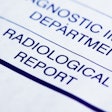Although the overall prevalence of medical educational debt among radiology-bound medical graduates has declined, graduates from self-identified racial and ethnic groups underrepresented in medicine (URiM) continue to be more likely to be burdened by it, according to a study published August 14 in the Journal of the American College of Radiology.
A team led by doctoral candidate Pavan Khosla of Yale University in New Haven, CT, found that graduates from self-identified racial and ethnic groups underrepresented in medicine had a higher likelihood of debt.
"[Our study found that] sociodemographic debt disparities persist, with older, male, and [those] underrepresented in medicine [being] more likely to have debt compared to their counterparts," the group noted.
Overall, U.S. healthcare -- but also particularly radiology -- is under pressure from factors such as physician shortages, increasing workload, decreasing reimbursements and salaries, and uncertainty around AI, the investigators explained, writing that "these factors influence the perception of radiology as specialty of choice among medical students."
"Medical educational debt has also been shown to influence decision making for individual medical graduates when they make career choices for specialization … [and] student debt levels negatively impact mental well-being and impact academic outcomes," they wrote. "As the cost of medical education increases, students have to weigh debt in context of its expected value for future earnings."
As little is known about the trends in medical education debt for graduates pursuing the field of radiology, the group conducted a study that included information from 6,477 responses to the Association of American Medical Colleges (AAMC) Graduation and Matriculating Student questionnaires between 2015 and 2024 from graduates pursuing radiology training who self-reported medical educational debt. The researchers adjusted medical educational debt between 2015 and 2024 for inflation.
They found an overall decrease in median medical educational debt (from $237,600 in 2015 to $200,000 in 2024), but higher likelihood of debt among graduates from self-identified racial and ethnic groups who are underrepresented in medicine (odds ratio [OR], 1.74); for example, Black graduates had more than twice the odds of debt compared with their white counterparts (OR, 2.19). Yet even with this increased likelihood of debt burden, the investigators noted lower total debt among indebted URiM graduates compared to their non-URiM counterparts ($208,530 vs. $226,600).
The investigators also reported the following:
- In 2015, 25.8% of indebted radiology-bound graduates indicated plans to use Public Service Loan Forgiveness (PSLF), which increased to 44.9% in 2024 (p< 0.001).
- In 2023, the median debt for radiology graduates represented between 35% and 45% of total annual compensation.
- Graduates entering radiology residencies had a lower proportion and lower median debt in 2024 compared to those pursuing anesthesia, emergency medicine, and family medicine, but higher than dermatology and ophthalmology.
These findings offer insights into the demographics of radiology-bound medical doctors, according to the group.
"Though the proportion of radiology-bound graduates with debt and their median debt amounts have declined over the past decade, graduates with medical education debt were more likely from lower-income households, to be older, and to report additional forms of debt such as pre-medical education or credit card debt," the team wrote.
The study suggests that more work is needed "to bridge this socio-economic gap, including offering scholarships, reduced tuition, or loan forgiveness options for URiM candidates," according to the investigators.
"While these findings may reflect complex interactions between access to scholarships, borrowing behavior, and institutional support, they underscore the need for targeted financial aid policies to improve equity and workforce diversity in radiology," they concluded.
The complete study can be found here.




















